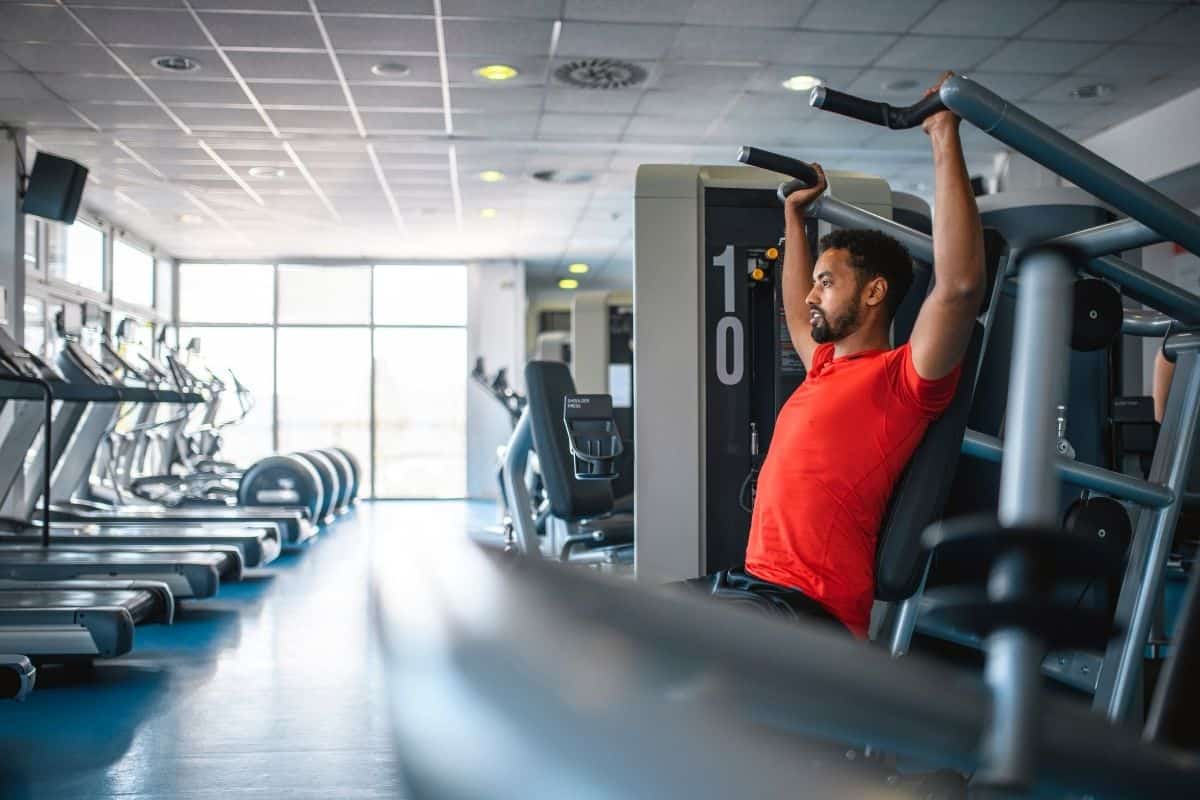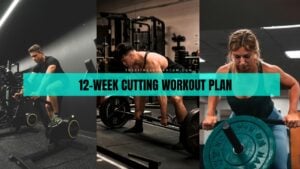The overhead press, also known as the shoulder press, is a compound push exercise that builds strength, power, muscle mass, and endurance.
It targets the shoulders, abs, and triceps and helps build a strong and athletic body.
In this article, I’ll show you how to perform various overhead presses and when to include them in your training program.
Whether you’re a bodybuilder, powerlifter, or an athlete, overhead press can help enhance your shoulder functionality and performance.
Muscles Worked During Overhead Presses
The overhead press is a multi-joint exercise that primarily strengthens the anterior and lateral deltoids of the shoulder.
The triceps are the second muscles that work when you fully extend your arms overhead.
The abdominals are also engaged when you perform overhead presses in the standing position.
The Overhead Press Techniques and Form
Doing the overhead press with the proper technique produces a better result and reduces the risk of injuries.
In the below video, Jeff Nippard, one of the renowned fitness instructors on YouTube, has beautifully explained how to do the overhead overpress with the perfect technique.
Here are some of the crucial points you can take into consideration while performing a shoulder press.
- Hold the bar or the dumbbells at your shoulder height.
- Keep your elbows tucked at your sides so they are facing forward.
- To get the most out of the overhead press, use a full range of motion, which means extending the elbows completely overhead.
- Don’t instantly press the weight up like a barbell push press. Do each rep in a controlled manner.
- Keep your chest up, back straight, and core tight during the entire movement. It will reduce the stress on the lower back and allow you to perform it safely and efficiently.
- Your arms should align with your body when you press the weight up.
Overhead Press Variations
You can do the overhead press in various ways and with several types of equipment.
For example, you can do seated overhead presses, standing OHPs, front overhead presses, and behind-the-neck shoulder presses.
You can do these shoulder press variations with multiple types of equipment, such as a barbell, dumbbell, Smith machine, shoulder press machine, kettlebell, and a resistance band.
The selection of an overhead press variation depends on what suits you most regarding safety and effectiveness.
1. Smith Machine Overhead Press

The Smith Machine helps lift heavy weights and build strength in a safe and effective way. It involves sitting under the rack and pressing weight until the delts are engaged.
Steps to perform:
- Place the bar in the rack at your shoulder height along with the weight plate.
- Now grab the bar with an overhand grip with your hands shoulder-width apart.
- Keep your back straight and chest up, and brace your core and glute muscles.
- Now press the bar upwards over your head until your arms are fully straight.
- Hold for about 2 seconds at the top and then slowly lower the bar back to the beginning position.
- Complete three to four sets, ten reps each, with 1 to 2 minutes rest between the sets.
2. Dumbbell Shoulder Press

The dumbbell overhead press is a free-weight exercise that helps build muscle and endurance.
With dumbbells, you can increase the intensity, change the direction, and effectively hit your shoulders.
Steps to perform:
- Stand upright with your feet shoulder-width apart, holding one dumbbell in each hand with an overhand grip, palms facing upward.
- Keep your elbows bent at your sides, hold your arms at shoulder height, and ensure the dumbbells are not far from your shoulder.
- Keep your back straight, chest up, and core tight. That’s the starting position.
- Now, press the dumbbells up toward the ceiling until your arms are straight.
- Hold for a second, then slowly lower the dumbbells back into the starting position. That’s one rep.
3. Barbell Overhead Press

The overhead barbell press, also known as the military press, engages more muscles than all other OHP variations.
It activates deltoids, abs, and triceps and helps stimulate strength and hypertrophy.
Many powerlifters and functional athletes use this exercise to increase pushing ability and power.
Steps to perform:
- Take out the bar, step back, and stand upright with your feet shoulder-width apart.
- Hold the bar at shoulder height with an overhand grip, palms facing up. Your hands should be at least shoulder-width apart.
- Keep your back straight and chest up, and brace your core and glutes. That’s the starting position.
- Now, press the bar up towards the ceiling until your arms are straight.
- Hold for a second, then slowly lower the bar into the starting position. That’s one rep!
- Complete three to four sets, ten reps each, with 1 to 2 minutes rest between each set.
- Inhale before pressing the bar and exhale after completing one rep.
4. Shoulder Machine Overhead Press

If you find it challenging to perform overhead presses with dumbbells or barbells, a machine is a viable alternative.
The machine provides a decent range of motion, can be easily loaded or unloaded, and helps press the weight effectively.
Steps to perform:
- Get into a seated position with the handles of the machine at your shoulder height.
- Keep your back and head rested on the resting pad, and grab the handles firmly with your palms facing up and elbows forward.
- Brace your abdominal muscles, inhale, and press the weight up.
- Lower the handles to the start. That’s your first rep.
5. Kettlebell Shoulder Press
With kettlebells, you can perform both single-arm and dual-arm overhead presses. The KB overhead press helps build strong and functional shoulders and improve wrist mobility, as it involves twisting wrists while pressing the bells overhead.
Steps to perform:
- Hold a pair of kettlebells with your hands at shoulder height. You can do this in a seated or standing position.
- Keep your abdominal muscles tight, then press the weight toward the ceiling until your arms are straight.
- Slowly return to the starting position and repeat for the desired reps and sets.
6. Resistance Band Shoulder Press
The resistance band is the best option for all those who train at home, as it builds decent strength and improves shoulder muscularity without free weights and machines.
Steps to perform:
- Start with standing straight with your feet slightly wider than shoulder-width apart.
- Place one end of the band under your feet and grab the other end firmly with your hands.
- Hold your hands beside your shoulders with your palms facing up. It is your starting point.
- Press the band upward until your elbows are fully extended and then lower to the start to complete one rep.
Benefits of The Overhead press
You’ll get a myriad of benefits if you do any of the variations of the shoulder press. Let’s see some of the important ones below.
1. Build Strong Delts
The overhead press is one of the best shoulder workouts, mainly on the front and middle deltoids. It also activates the rear delt muscle to some extent. 1Effects of body position and loading modality on muscle activity and strength in shoulder presses– Journal of Strength and Conditioning Research
Building bigger and rounded delts is an excellent workout because the overhead press contributes nearly 50 percent of all shoulder workouts.
It doesn’t matter how big your bicep and tricep are; your arms will look underdeveloped if you have poor delts.
2. Strengthen The Core
The standing variation of the shoulder press activates core muscles during the movement.
Proper form and technique in the shoulder press increase core strength and help build a solid upper body structure.
A solid core has numerous benefits, such as helping you push, pull, and lift heavier weights and improving overall performance.
3. Improve Grip Strength
The overhead press also increases the strength of your grip. Having a solid grip helps you lift heavy weights (such as a deadlift) soundly.
4. Promote Muscle Growth
The shoulder press is a helpful compound exercise that activates several muscles at once and promotes hypertrophy. (check out the free hypertrophy workout routine)
The different types of overhead press work on multiple muscles like delts, traps, triceps, and the core.
If you notice your traps at the time of the overhead press, you can feel how your traps activate and expand throughout the workout. Doing shoulder presses often will help you develop your traps.
The shoulder press may also be great for stimulating the triceps muscles. However, the long head is the major tricep muscle engaged during the workout.
The shoulder press is a must-do exercise for muscle growth, and you must include it in your workout routine.
5. Other Benefits
- The overhead press may also improve posture.
- Doing shoulder presses may also improve bench press.
- In some cases, the standing shoulder press may also enhance arm swing power, increasing the jumping abilities.
Behind the Head vs. Front Overhead Press
Behind The Head, the shoulder press puts more stress on the Thoracic Spine than the front overhead press. 2Overhead shoulder press – In front of the head or behind the head? – Science Direct (2013)
However, both are effective. They increase strength and promote muscle growth. Both variations are also safe for the shoulders and spine.
You can include both variations in your workout routine or do each variation in different periods to check which one is more effective for your shoulder.
Overhead Press Alternatives
Pike and handstand push-ups are two possible and effective alternatives to overhead press.
However, they require strong and flexible shoulders so that you can do them effectively.
References
- 1Effects of body position and loading modality on muscle activity and strength in shoulder presses– Journal of Strength and Conditioning Research
- 2Overhead shoulder press – In front of the head or behind the head? – Science Direct (2013)






